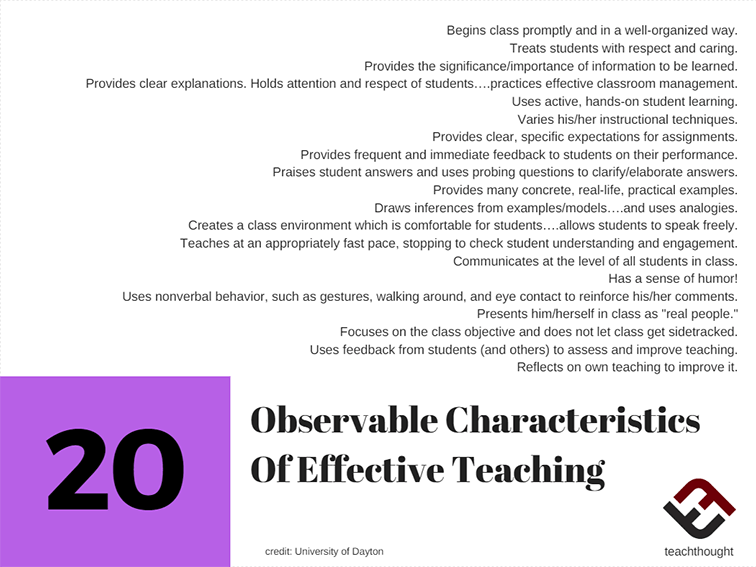
20 Observable Characteristics Of Effective Teaching
by TeachThought Staff
What makes an effective teacher? Or more specifically, what observable characteristics might you see and hear?
The University of Minnesota offered some observable characteristics of effective teaching which, while focused on teacher actions rather than student learning, had some useful tips–not so much how to teach generally, but specific actions that you can use tomorrow.
In “How A Good Teacher Becomes Great,” we theorized that good teachers know which assessments are for ‘show’ and which are for ‘go’—that is, which look good from 10 feet and which provide visibility for both the student and teacher where the learning needs to go next, and that they model curiosity, collaborate with other great teachers, and “measure understanding in diverse ways.”
Below are 20 observable characteristics of effective teaching. Pair this with our characteristics of a highly-effective learning environment and you’ll have a nice one-two punch to reflect on your craft. We’ve highlighted a few of our favorites to get you started.
See also Reading Logs With Reading Strategy Reminder Bookmarks
20 Observable Characteristics Of Effective Teaching
- Begins class promptly and in a well-organized way.
- Treats students with respect and caring.
- Provides the significance/importance of information to be learned.
- Provides clear explanations. Holds attention and respect of students….practices effective classroom management.
- Uses active, hands-on student learning.
- Varies his/her instructional techniques.
- Provides clear, specific expectations for assignments.
- Provides frequent and immediate feedback to students on their performance.
- Praises student answers and uses probing questions to clarify/elaborate answers.
- Provides many concrete, real-life, practical examples.
- Draws inferences from examples/models….and uses analogies.
- Creates a class environment which is comfortable for students….allows students to speak freely.
- Teaches at an appropriately fast pace, stopping to check student understanding and engagement.
- Communicates at the level of all students in class.
- Has a sense of humor!
- Uses nonverbal behavior, such as gestures, walking around, and eye contact to reinforce his/her comments.
- Presents him/herself in class as ‘real people.’
- Focuses on the class objective and does not let class get sidetracked.
- Uses feedback from students (and others) to assess and improve teaching.
- Reflects on own teaching to improve it.
